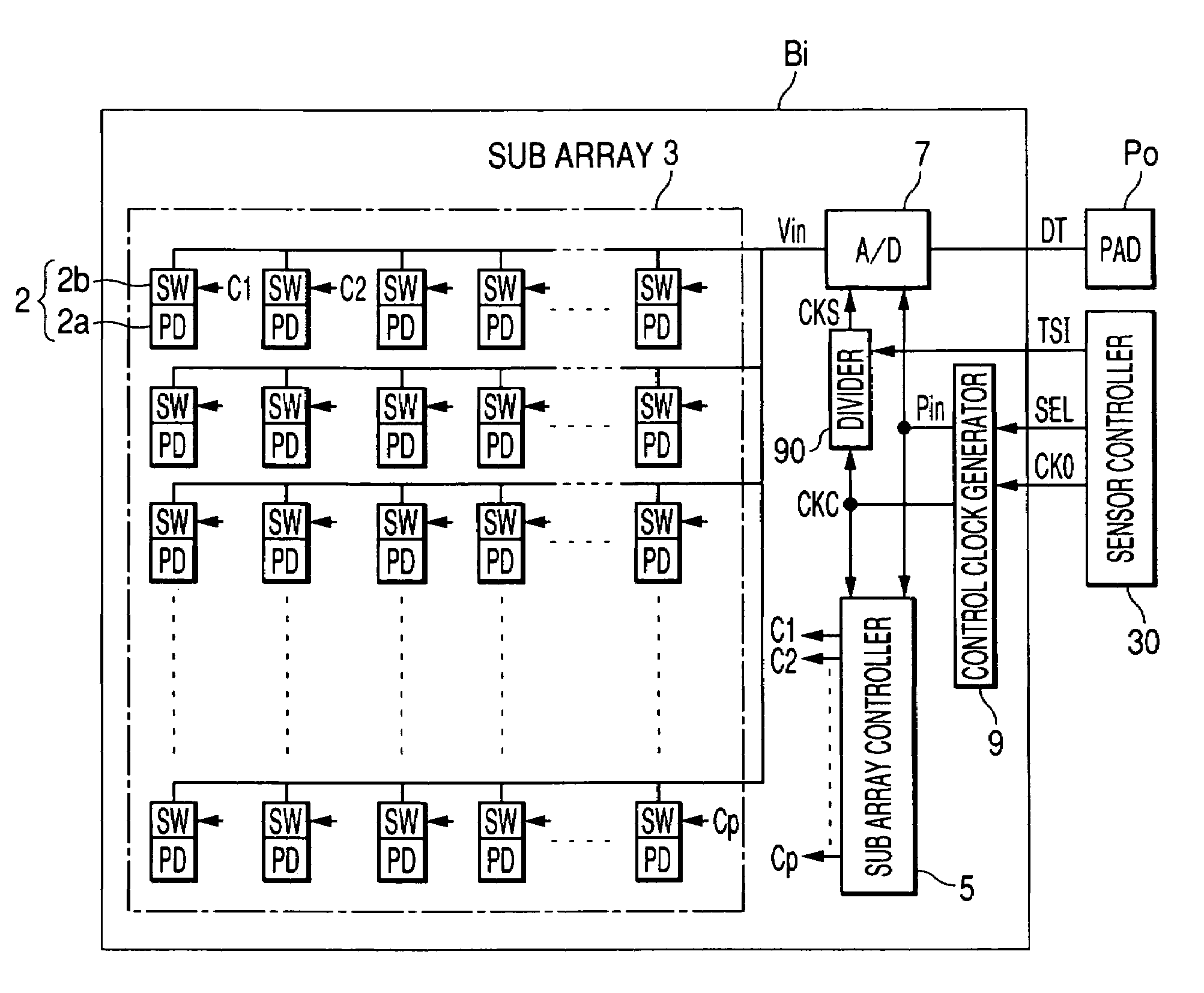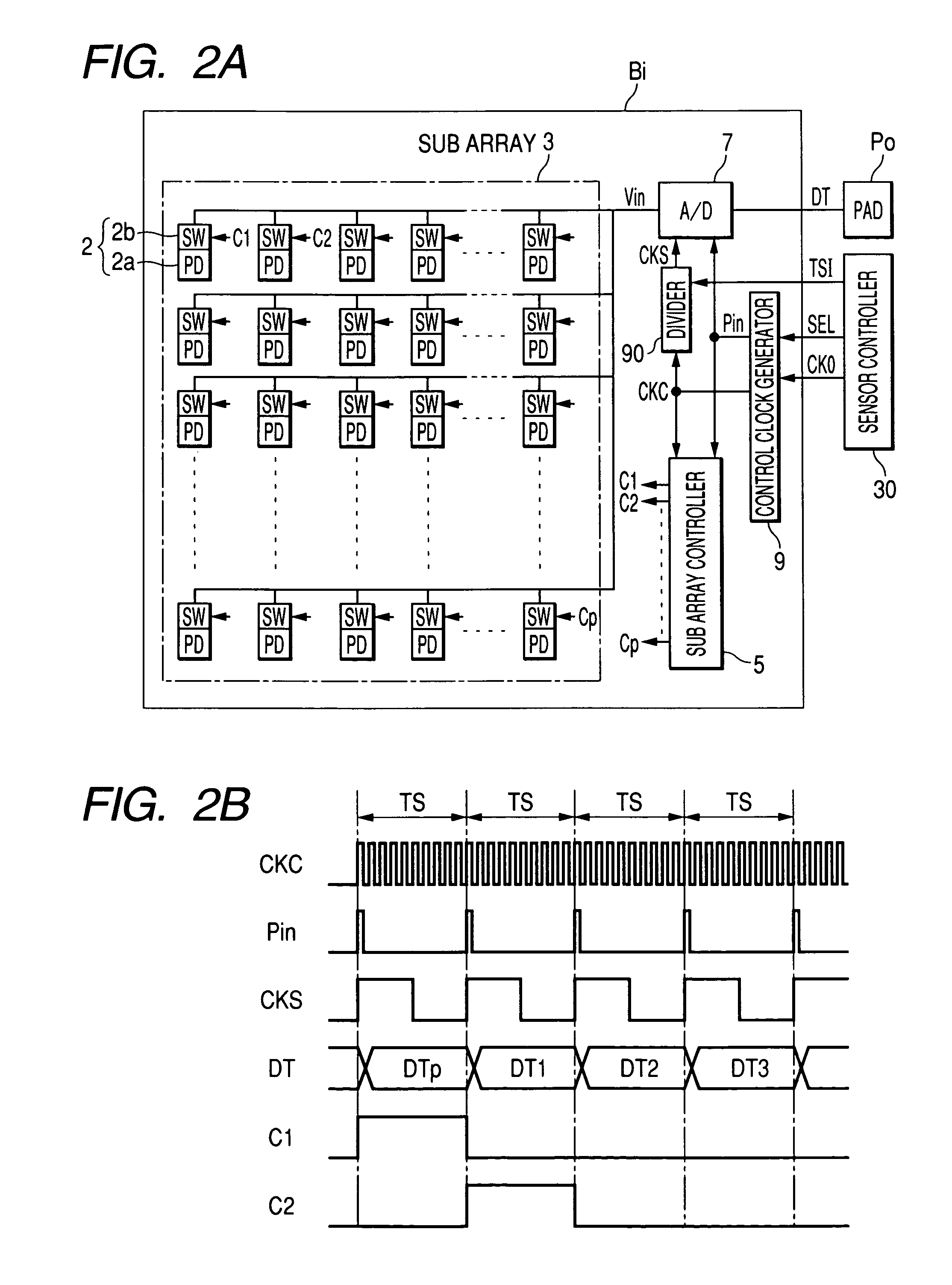Image sensor and control method of the image sensor
a control method and image sensor technology, applied in the field of image sensors, can solve the problems of affecting the operation speed of the counter 105, affecting the quality of the image sensor, and becoming difficult to apply the image sensor having such an a/d converter to products requiring high speed operation, etc., to achieve high resolution, high accuracy, and high speed
- Summary
- Abstract
- Description
- Claims
- Application Information
AI Technical Summary
Benefits of technology
Problems solved by technology
Method used
Image
Examples
first embodiment
[0037]FIG. 1 is a block diagram showing a configuration of an image sensor 1 according to the first embodiment of the present invention. In particular, FIG. 1 shows an arrangement of plural array blocks Bi (i=1 to 20 in the embodiment) arranged in matrix form and peripheral units in the image sensor 1 of the first embodiment. The peripheral units are output pads Po and plural pads (not shown). Each array block Bi has the corresponding output pad Po. Through the plural pads (not shown), signals of various types excepting the output signals transferred through the output pads Po are input and output. The output signal from each array block Bi (i=1 to 20) is transferred through the corresponding output pad Po. As shown in FIG. 1, those output pads Po and the other plural pads are formed at the peripheral area of the array block, that is, formed at the peripheral section of the IC chip. Although FIG. 1 shows only one transfer line through which the output pad Po and each array block Bi ...
second embodiment
[0086]Next, a description will now be given of the image sensor according to the second embodiment of the present invention. The difference between the first embodiment and the second embodiment is the data collection in the zoom-in process (or zoom-up process).
[0087]FIG. 7 is a flow chart showing the process of the zoom-in data collection in the image sensor according to the second embodiment of the present invention.
[0088]First, target array blocks Bi to be processed and the number “n” of the target array blocks Bi are specified based on a zoom-in instruction signal supplied from an external device of the array block Bi such as the sensor controller 30 (step S210).
[0089]Based on the total number “m” of the array blocks Bi and the number “n” of the target array blocks specified in step S210, an iteration number “k” (=[m / n]) is calculated and a variable “j” is initialized to 1 (step S220), where [x] means an integer part of the value “x”.
[0090]Following, the variable “i” for identif...
third embodiment
[0103]Next, a description will now be given of the image sensor of the third embodiment according to the present invention with reference to FIG. 8.
[0104]FIG. 8 is a block diagram showing a configuration of an A / D conversion circuit (also showing a part of a circuit diagram) in an array block in the image sensor according to the third embodiment. The difference between the third embodiment and the first embodiment is the configuration of the A / D conversion circuit. Other components of the third embodiment are the same of those of the first embodiment.
[0105]As shown in FIG. 8, a delay unit DU of an initial stage forming a pulse delay circuit 10a that forms an A / D conversion circuit 7a in the image sensor of the third embodiment is made of an AND gate DUa. The input pulse Pin as an initiation signal is input to one input terminal of the AND gate DUa. Another input terminal of the AND gate DUa is connected to the output terminal of the delay unit DU of the final stage. Thus, all of the...
PUM
 Login to View More
Login to View More Abstract
Description
Claims
Application Information
 Login to View More
Login to View More - R&D
- Intellectual Property
- Life Sciences
- Materials
- Tech Scout
- Unparalleled Data Quality
- Higher Quality Content
- 60% Fewer Hallucinations
Browse by: Latest US Patents, China's latest patents, Technical Efficacy Thesaurus, Application Domain, Technology Topic, Popular Technical Reports.
© 2025 PatSnap. All rights reserved.Legal|Privacy policy|Modern Slavery Act Transparency Statement|Sitemap|About US| Contact US: help@patsnap.com



